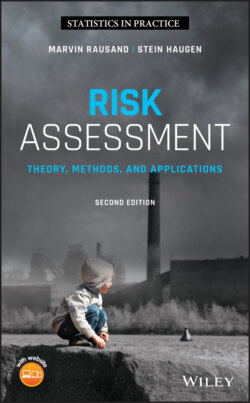Читать книгу Risk Assessment - Marvin Rausand - Страница 20
1.6 Objectives, Scope, and Delimitation
ОглавлениеThis book is written for students, engineers, and analysts engaged in risk assessments, both in the design phase and in the operational phase of systems.
The main objective of the book is to give a thorough introduction to risk assessment and to present the essential theory and the main methods that can be used to perform a risk assessment.
More specific objectives are
1 To present and discuss the terminology used in risk assessment. Optimistically, we hope that this may contribute to a more harmonized terminology in risk assessment.
2 To define and discuss how risk can be quantified and how these metrics may be used to evaluate the tolerability of risk.
3 To present the main methods for risk analysis and discuss the applicability, advantages, and limitations of each method.
4 To present and discuss some specific problem areas related to risk assessment (e.g. human errors, dependent failures).
5 To describe how a risk analysis may be carried out in practice and illustrate some important application areas.
The book is concerned with risk related to (i) A technical or sociotechnical system, in which (ii) events may occur in the future, that have (iii) unwanted consequences (iv) to assets that we want to protect.
The systems considered may be any type of engineered system, ranging from small machines up to complex process plants or transportation networks.1 The book does not cover all aspects of risk, but is limited to accidents where a sudden event harms one or more tangible assets. Adverse effects caused by continuous and long‐term exposure to a hazardous environment or hazardous substances (e.g. asbestos) are thus not covered unless the exposure is caused by a specific event (e.g. an explosion).
When people or the environment is exposed to hazardous chemicals, the risk is traditionally analyzed by dose–response models, also called exposure–response relationship. This topic is not covered in the book. The book is concerned with the consequences of accidents, but does not describe how we can calculate or otherwise determine the physical effects of accidents. Examples include the impact energy involved in a collision between two cars, the size and intensity of a fire, or the overpressure generated by an explosion. Instead, the methods focus on the probabilistic aspects of the analysis.
In the financial world, investments involving risk of losing money are often made. The outcome may be either positive or negative, and risk is then a statement about the uncertainty regarding the outcome of the investment. This interpretation of the word risk is not relevant for this book, which is concerned exclusively with adverse outcomes. In general, events that harm only intangible assets (e.g. finances, reputation, and goodwill) are not covered in the book, unless this (intangible) harm is associated to an event harming a tangible asset.
The main focus of the book is risk assessment per se, not how the results from the assessment may be used or misused, but some issues related to risk management are discussed briefly in Chapter 7.
The book is mainly focused on the study of major accident risk. Many of the methods described may be used to analyze and prevent minor accidents, such as occupational accidents, but this is not the main focus of the book. Risk related to deliberate actions, such as sabotage and cyberattacks, is not a main focus of the book, but an introduction to this increasing problem is given in Chapter 17. Environmental risk and resilience are likewise treated only very briefly.
